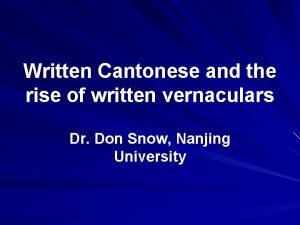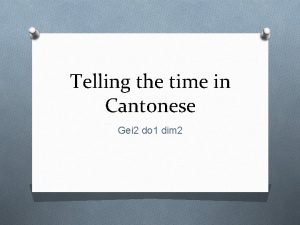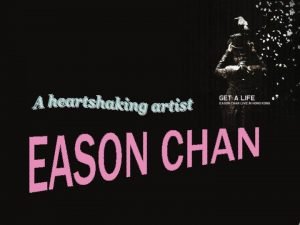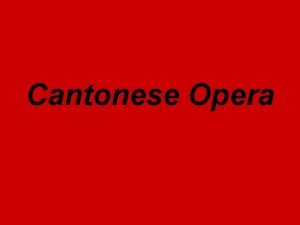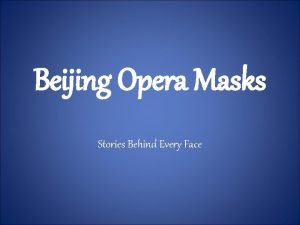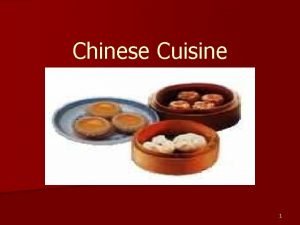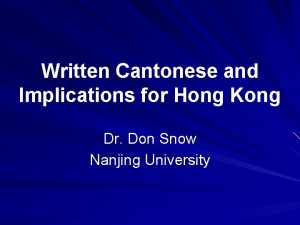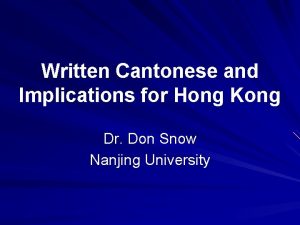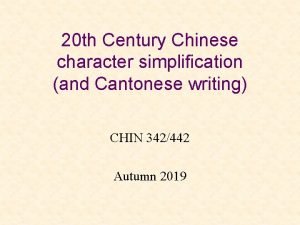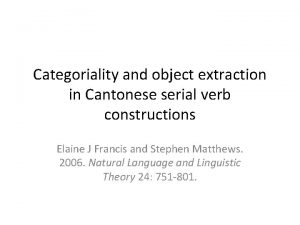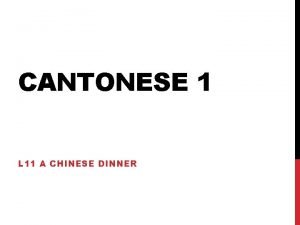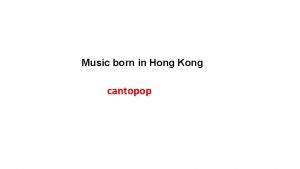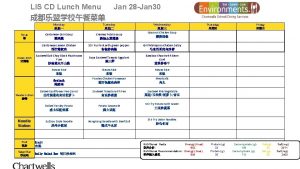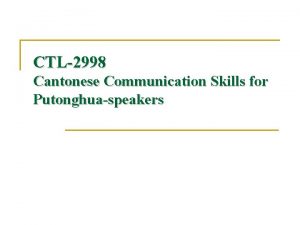Written Cantonese and the rise of written vernaculars



















- Slides: 19

Written Cantonese and the rise of written vernaculars Dr. Don Snow, Nanjing University

Diglossia Describes situations in which a society uses two different language varieties for different functions: – A "low" (L) language for daily conversation; – A "high" (H) language formal purposes, including most or all writing.

Characteristics of diglossic situations L is the daily spoken language; H is not used for ordinary conversation. L is learned naturally at home; H is learned primarily in school. Little - if anything – is written in L. H is a written language with a strong literary tradition. L is generally considered low and vulgar; H is generally considered superior to L - more beautiful, more logical, better for expressing lofty thoughts. L has few formal standards. H has clearly stated standards, and there is generally a strong tradition of the formal study of H within the community; for example, there are dictionaries, grammars, formal codes of orthography, and so forth.

Case 1: China Before 1900 s, Classical Chinese dominant written language in China. However, Baihua already existed and had a long history. – Appears first in Tang Dynasty bianwen texts. – Grows through use in vernacular fiction. In early 1900 s, reformers advocate use of Baihua in order to promote literacy, education, and modernization. From 1920 s on, Baihua gradually replaces Classical Chinese. For example, in 1920 s, adopted by government as the language for school textbooks.

Case 2: Japan Classical Chinese the dominant written language in traditional Japan. However, quite early written Japanese used in some kinds of poetry, private writing, and low-prestige writing such as women’s literature. – Heian period Japan (794 -1185) – wabun Japanese prose, waka Japanese poetry. – Tale of Genji all in Japanese in hiragana, cir. 1001 -1010. In Meiji period (late 1800 s) reformers argue it is too difficult to promote mass education using Classical Chinese. (Many aware of close relationship between spoken/written language in Europe. ) During late 1800 s/early 1900 s, written Japanese replaces Classical Chinese in fiction writing – paves way for use of written Japanese in other genres. Early 1900 s – written Japanese becomes main language of newspapers; later of school textbooks. In 1946, written Japanese becomes the language of official documents.

Case 3: Korea Classical Chinese the dominant written language in pre-modern Korea. However, some use of the vernacular in certain kinds of writing: – Hyangga �歌 between 600 s and 880 s – vernacular poetry transcribed in Chinese characters. – Also hyangch’al �札 system of writing, using Chinese characters but completely Korean word order. Hangul – announced in 1446 – though little used until late 1800 s. Late 1800 s – progressives begin to use written Korean in newspapers. 1894 – royal decree that all government documents be printed in Korean. 1910 – movement to unify spoken and written language. Onset of Japanese colonization ends promotion of written Korean – Japanese promoted instead. After independence from Japan, written Korean promoted vigorously in both North and South Korea – Hangul becomes a symbol of great national pride.

Case 4: Vietnam Classical Chinese as dominant pre-modern language. In pre-modern period, there was a written language called Nom Vietnamese represented with Chinese characters, used for writing certain kinds of texts such as vernacular poems. After Vietnam becomes a French colony, colonial authorities promote Romanized Vietnamese (Quoc Ngu) as the written language through use in schools – in part to reduce Chinese influence. Nom gradually dies out as fewer and fewer people educated to read Chinese characters. Initially Quoc Ngu resisted by many Vietnamese, but gradually nationalist leaders become more supportive of it because they feel some degree of westernization is necessary for national strengthening.

Case 5: Chinese dialect writing Wu dialect used in printed texts of songs, operas; also in turn-of-the-century fiction. Southern Min used in pre-modern opera, song texts; written Taiwanese promoted in recent decades as a symbol of cultural nationalism, used in fiction and even academic texts. Cantonese used first in song, opera texts, later in newspaper articles; used in Hong Kong today in many kinds of newspaper and magazine articles, some fiction, and advertising.

“Popular development” of vernacular writing – defined as: Development that is not actively promoted by any organized and influential social group. Development that, rather, grows as a result of popular “demand, ” driven by personal factors such as the following: – The vernacular is easy to learn to read and write. – For writers, using the vernacular makes it easier to express personal feelings. – For readers, use of the vernacular creates stronger sense of emotional immediacy, personal intimacy, and in-group closeness. Such development may also be driven by market factors.

Generalization #1 Written vernaculars tend to expand into domains where there is less social pressure to adhere to a written standard. (The “path of least resistance” factor. ) In particular, they more readily establish a foothold in texts where use is sanction by one or more of the following characteristics: – – – The content/purposes of the text are “light” rather than serious. The authors and/or audience are of low social class. The text is perceived as being associated with settings that are informal or even disreputable. The publication in which the text appears is “cheap” – inexpensive and low in prestige. The text preserves/replicates spoken language – or at least appears to do so.

Generalization #2 The shift from a written language norm to a vernacular norm tends to be gradual, with intermediate stages in which written language and vernacular norms are mixed.



Generalization #3 It is easier for a written vernacular to become widely known and used if the “cost” of learning it is not so great. (Cost/benefit factor #1. )


Generalization #4 It is easier for a written vernacular to become widely known and used if the “benefits” of learning are relatively high; in other words, if the texts written in the vernacular tend to be appealing. (Cost/benefit factor #2. )


Generalization #5 In speech communities that are “vital” wealthy, powerful, autonomous, and so forth - it is natural for spoken vernaculars to develop written forms.

Works referred to Anderson, Benedict (1991) Imagined Communities: Reflections on the Origin and Spread of Nationalism, revised edition, London: Verso. De. Francis, John. (1977) Colonialism and Language Policy in Vietnam. The Hague: Mouton Publishers. Ferguson, Charles (1959) "Diglossia, " Word 15: 325 -40. Hanan, Patrick (1981) The Chinese Vernacular Story. Cambridge: Harvard University Press. Lee, Iksop, and Robert Ramsey (2000) The Korean Language. Albany: State University of New York Press. Shibatani, Masayoshi (1990) The Languages of Japan. Cambridge: Cambridge University Press. Snow, Don. (2004) Cantonese as Written Language: The Growth of a Written Chinese Vernacular. Hong Kong: Hong Kong University Press. Sohn, Ho-Min (1999) The Korean Language. Cambridge: Cambridge University Press. Song Zelai 宋澤萊 (1987) "Khong-po e Phah Miau Chhi, " 抗暴个打貓市 (The Violent Protest Of Da Mao City), in Song Zelai, Ruoxiao minzu 弱小民族 (A Weak Small People), Taipei: Qianwei chubanshe 前衛出版社. Takeuchi, Lone (1999) The Structure and History of Japanese: From Yamatokotoba to Nihongo, London: Longman. Twine, Nanette (1991) Language and the Modern State: The Reform of Written Japanese, London: Routledge.
 Written cantonese
Written cantonese Tricky dick
Tricky dick Rise and rise until lambs become lions
Rise and rise until lambs become lions Raise and rise again until lambs become lions
Raise and rise again until lambs become lions Rise and rise again until lambs become lions origin
Rise and rise again until lambs become lions origin Saam yi yat
Saam yi yat Tvb singers male
Tvb singers male Zhezhi in peking opera
Zhezhi in peking opera It signifies fierceness ambition and cool headedness
It signifies fierceness ambition and cool headedness Cantonese vowels
Cantonese vowels Tan in cantonese
Tan in cantonese Hát kết hợp bộ gõ cơ thể
Hát kết hợp bộ gõ cơ thể Frameset trong html5
Frameset trong html5 Bổ thể
Bổ thể Tỉ lệ cơ thể trẻ em
Tỉ lệ cơ thể trẻ em Voi kéo gỗ như thế nào
Voi kéo gỗ như thế nào Chụp phim tư thế worms-breton
Chụp phim tư thế worms-breton Alleluia hat len nguoi oi
Alleluia hat len nguoi oi Môn thể thao bắt đầu bằng từ đua
Môn thể thao bắt đầu bằng từ đua Thế nào là hệ số cao nhất
Thế nào là hệ số cao nhất
